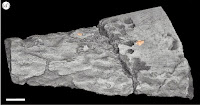Acoelomate Worms are microscopic
animals resembling Platyhelminths and formerly thought to be closely
related to them. They share the same basic body-plan, with a flattened body
comprising two layers of cells without separating tissue and a non-through gut,
but recent genetic studies have suggested the groups are unrelated, having come
up with the same simple bodies as a result of convergent evolution. However
these studies have been unable to resolve the exact relationship between
Acoelomate Worms and other animals, with suggestions that they might be the
sister group to the Bilaterians (basically all animals except Sponges,
Cnidarians and Ctenophores), a position which was formerly suggested for the
Platyhelminths as a whole, or that they might be Deuterostomes, members of the
group which includes Vertebrates and Echinoderms.Aceolomate Worms are
predominantly marine animals, but have been studied very little away from the
Baltic, so the full range of habitats they inhabit is probably not known.
In a paper published in the journal Zootaxa on 1 April 2015, Thomas
Zauchner, Willi Salvenmoser and Bernhard Egger of the Institute of Zoology at the University of Innsbruck describe a new species of Acoelomate Worm from interstitial sands
collected from the beach at Marina di Pisa in Italy, on the coast of the Liguric
Sea (part of the Mediterranean).
The new species is placed in the genus Aphanostoma, and given the specific name pisae, in reference to the area where it was found. The worms are
transparent and reach 400-700 μm in size on reaching maturity. They bred well
in captivity, laying eggs which hatched after 46 hours, leading Zauchneret al. to suggest that they might make
good animals for laboratory studies of the group.
Live differential interference contrast image of Aphanostoma pisae. Mature animal,
anterior to the right. Scale bar is 100 μm.
See also…
Siboglinid Worms are a distinctive group of Annelids which lack
mouths and digestive tracts in their...
Sphaerularid Nematodes are highly virulent parasites
of Insect hosts. While most parasites seek to keep their host alive for
as long
as possible, enabling them to live and produce offspring for as long as
possible, Sphaerularids begging to reproduce at a high...
Trematode Flatworm infections are
very common in freshwater Fish, but tend not to be well studied except...




